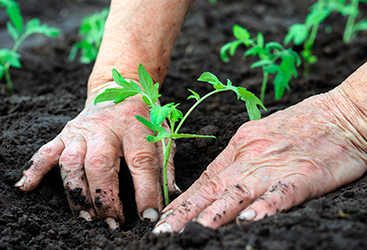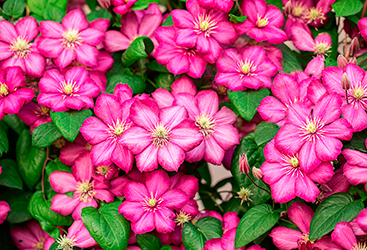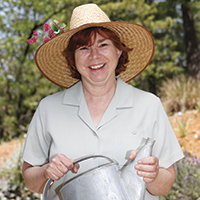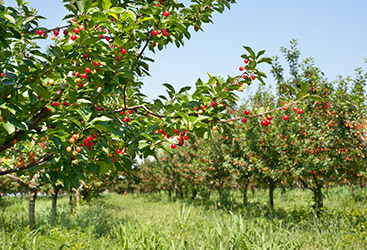Gardening Q&A
-
As a California Bountiful reader, you have the opportunity to get your seasonal gardening questions answered by gardening expert Pat Rubin. Here are a few questions from other readers.

The stems on my tomato and bean seedlings are long and spindly. The plants are beginning to flop over. I have them near a sunny windowsill, so what is wrong?
Sunny windowsill aside, the plants are still not getting enough light. On nice days, take the seedlings outside and let them have some natural sunlight. Be careful not to leave them outside too long because they are not used to cooler temperatures and direct sunlight. Just leave them out for a half hour at first. Next, run your hand lightly across the seedlings several times each day. This will help the spindly stems develop some strength and stand up straight. It isn't so much a problem with tomatoes because you can plant the seedlings all the way up to the top set of leaves. The stems will then root and give the plant extra strength. You can't do the same with other seedlings. Beans can't go into the ground until April in most parts of California. Because they sprout so quickly, you might want to wait a few weeks longer next year before you start the seeds

My clematis never blooms anymore. It was blooming when I bought it. I prune some of the old growth back each spring, but what's going on?
You may be pruning it at the wrong time of year. Spring blooming clematis must be pruned after they bloom in the spring, not in late winter before they bloom. Otherwise you're cutting off the blooming wood before it gets a chance to bloom. Let it go this spring and see what happens. Other types of clematis bloom in summer and fall, and these types can be pruned in late winter. One more thing, and it is a pet peeve of mine: Be sure to pronounce it CLEM-a-tis, not Cle-MAT-is.
About Pat Rubin, California Bountiful's gardening expert

Pat RubinFor Pat Rubin, gardening is more than just dirt and plants. "It's about history, romance, adventure and people," she says. "And it should be fun."
California Bountiful's gardening columnist has lived and chronicled this fun, hands-in-the-dirt approach for years—and for additional publications including Fine Gardening, Pacific Horticulture, Christian Science Monitor, Family Circle and The Sacramento Bee. Pat has also volunteered as a Master Gardener, speaks to garden clubs and appears regularly on gardening radio shows.
Need gardening advice? Ask the expert!
Send your questions to gardening@californiabountiful.com
-
 Use dormant oil annually to help control scale in cherry trees.
Use dormant oil annually to help control scale in cherry trees.As a California Bountiful reader, you have the opportunity to get your seasonal gardening questions answered by gardening expert Pat Rubin. Here are a few questions from other readers.
My cherry tree has been failing the last couple of years, and I noticed it has lots of smooth, brown bumps on the trunk. Is it supposed to have those? I never noticed them before.
Your tree has scale—insects that look like smooth lumps the same color as the tree bark. Beneath that hard lump is a tiny insect feeding on your tree. A few don't usually bother the tree, but in large numbers can cause the tree to decline, perform poorly and even die. You can take a small knife and pry the hard shell away from the tree to find the mother scale, or even eggs for the next batch to attack your tree. Also look for ants crawling up and down the tree. The honeydew secreted by the scale insects attracts ants. The ants will keep away insects that are enemies of the scale. (Sticky tape around the base of the tree takes care of the ants.)
Control of the scale is easy: dormant oil, or horticultural oil. It's harmless to the tree and environment, and smothers the scale. It must be applied when the tree is dormant. Dormant oil is part of the yearly list of chores for caring for fruit—and many other types of trees—anyway, so make it a part of fall and winter care. Scale attacks many other sorts of ornamental trees too. Read the label to make sure horticulture oil is safe to use on the type of tree you want to treat.
When do I start tomato seeds so my plants are ready for spring planting?
February is time for planting tomato seeds. But they'll need warmth to sprout and plenty of light to develop strong stems. Seeds sprout when soil temperatures warm to about 55 degrees. Many growers who like to get seeds going early use warming mats. Simply place the pots or flats on the mats, and turn them on. That's the easy part. Once seedlings are up, they need light. Sunny windowsills can work great. If your seedlings are spindly and leggy, they are not getting enough light. I move my seedlings to the sunniest spots each day, making sure I turn the pots so the seedlings don't grow crooked to one side. If the weather is nice, I take them outside in the direct light for a short period.
Many gardeners use grow lights. The trick is to keep the lights just a few inches above the seedlings, and raise the lights as the plants grow. If the lights are too high, the seedlings will try to reach them, and you'll, again, have spindly, leggy plants. Another way to prevent leggy seedlings is to run your hand across them a few times each day or have a fan that blows across them occasionally. Movement makes the stems stronger.
Even if you do get some spindly growth, it's not necessarily a serious fault for tomatoes because you can plant the seedling deep enough to cover the stem all the way up to the leaves.
About Pat Rubin, California Bountiful's gardening expert

Pat RubinFor Pat Rubin, gardening is more than just dirt and plants. "It's about history, romance, adventure and people," she says. "And it should be fun."
California Bountiful's gardening columnist has lived and chronicled this fun, hands-in-the-dirt approach for years—and for additional publications including Fine Gardening, Pacific Horticulture, Christian Science Monitor, Family Circle and The Sacramento Bee. Pat has also volunteered as a Master Gardener, speaks to garden clubs and appears regularly on gardening radio shows.
Need gardening advice? Ask the expert!
Send your questions to gardening@californiabountiful.com
-
As a California Bountiful reader, you have the opportunity to get your seasonal gardening questions answered by gardening expert Pat Rubin. Here are a few questions from other readers.
Can I use sawdust to help build up the soil in the vegetable garden?
Sort of. If you mix sawdust into the soil, it will use all the nitrogen it can find to break down so that it can provide nutrients to plants. But during that process, there will be no nitrogen for the plants to use. So it's best to compost the sawdust before you add it to the soil, or plan on not being able to grow much of anything while the sawdust is decomposing in the dirt.I love ornamental grasses in late fall and winter when they turn beautiful colors. What are the best ones to plant?
Ornamental grasses are certainly beautiful all summer and add movement to the garden, but I agree they really come into their own in the winter when they are actually dying back. The greens turn to a beautiful gold. My favorites are Calamagrostis acutiflora, Stipa gigantea and any miscanthus you can find. If you look in nurseries at this time of year for grasses, they will look messy because they don't like growing in pots, but don't be afraid to buy them. I leave their dormant, dying foliage until January when it starts falling apart. Truly, there are many plants that look as beautiful when they die back as they do at their peak.Why does the nursery staff always suggest I buy an odd number of a plant?
Unless you are looking for a very formal, symmetrical look, it's always better to plant in odd numbers. I try to buy three or five of a single plant because it gives you more bang for the buck and looks more like Mother Nature had a hand in the design. Buy in odd numbers, but vary the groups—don't always buy three because that will end up looking as spotty as if you only bought one of something.About Pat Rubin, California Bountiful's gardening expert

Pat RubinFor Pat Rubin, gardening is more than just dirt and plants. "It's about history, romance, adventure and people," she says. "And it should be fun."
California Bountiful's gardening columnist has lived and chronicled this fun, hands-in-the-dirt approach for years—and for additional publications including Fine Gardening, Pacific Horticulture, Christian Science Monitor, Family Circle and The Sacramento Bee. Pat has also volunteered as a Master Gardener, speaks to garden clubs and appears regularly on gardening radio shows.
Need gardening advice? Ask the expert!
Send your questions to gardening@californiabountiful.com

